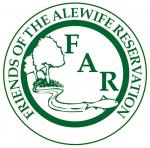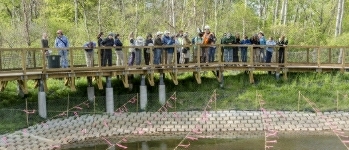Between July 6th and August 14th, ten Cambridge high school aged students make progress on a River Restoration project, work to enhance the Alewife Reservation and learn about local Ecology. This is FAR's 9th annual Summer Ecology Camp.
River Restore Program Report
FAR's 9th Summer Ecology Camp has been working on a "River Restore" project for the last 6 weeks along Little River.
Students have been making observations, and conducting scientific research with several professional consultants
to identify problematic areas on the river and devise solutions which can be completed by FAR volunteers
or brought to the attention of state groups and professional environmental firms in the near future.
You will find "Priorities for Action" on pages 23 - 25 which outline our substantial ideas for improving
Little River and its banks and streams.
FAR plans to partner with city officials, grassroots groups, municipal bodies and other volunteers to
implement these improvements projects beginning in the Fall of 2015.
Please email info@friendsofalewfiereservation.org to find out how you can support FAR's Little River restoration efforts.
Check out the River Restore Program Report.
Check out these pictures of our awesome campers and descriptions of their activities below the pictures.
Students planting and maintaining a community garden in Fresh Pond with the help of expert gardener, Stephen Gillies
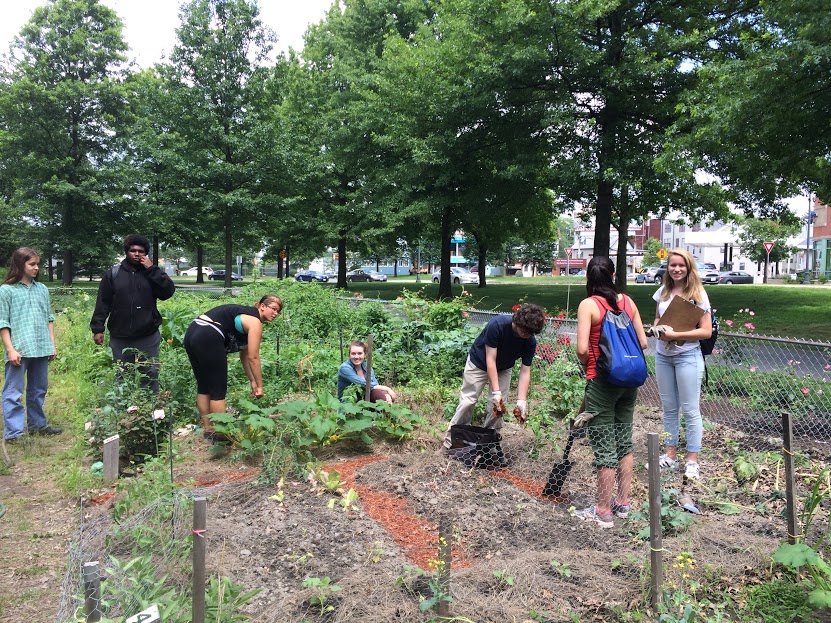
Flying kites while learning about wind's effects on the enviroment

Students and supervisors after a tour of the Deer Island Waste Water Management Facitlity
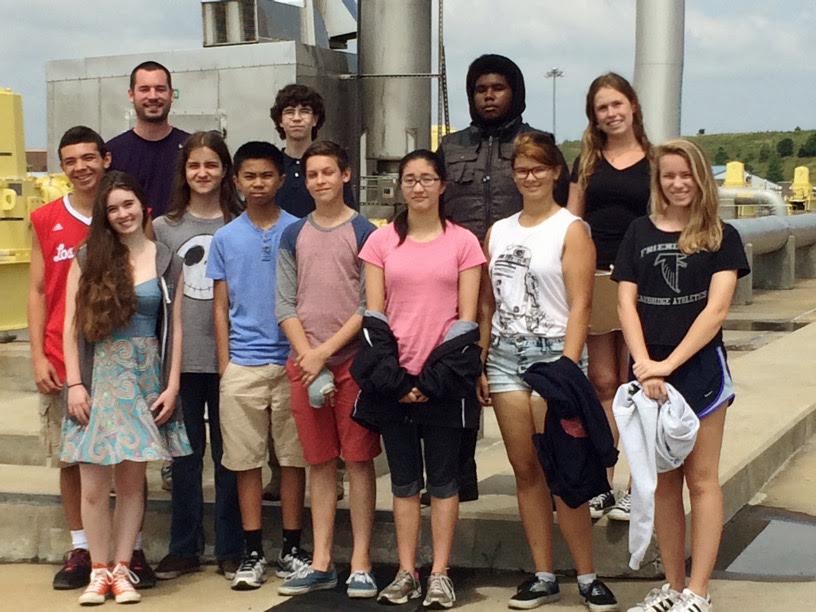
The "Erosion Explosion" Stream Team makes observations of current conditions on Little River

Ecology Camp students, Mia Smith, Zenon Padua III, Eli Neugeboren, Nicolas Livon-Navarro, Madelaine Smith,
Jacqueline Park and Jake Stout pose with their fieldwork gear before sampling for macroinvertebrates with
Nature Conservancy scientist, Arlene Olivero.

Jake Stout and Natalia Ruiz test water quality at a cross-tributary on Little River.
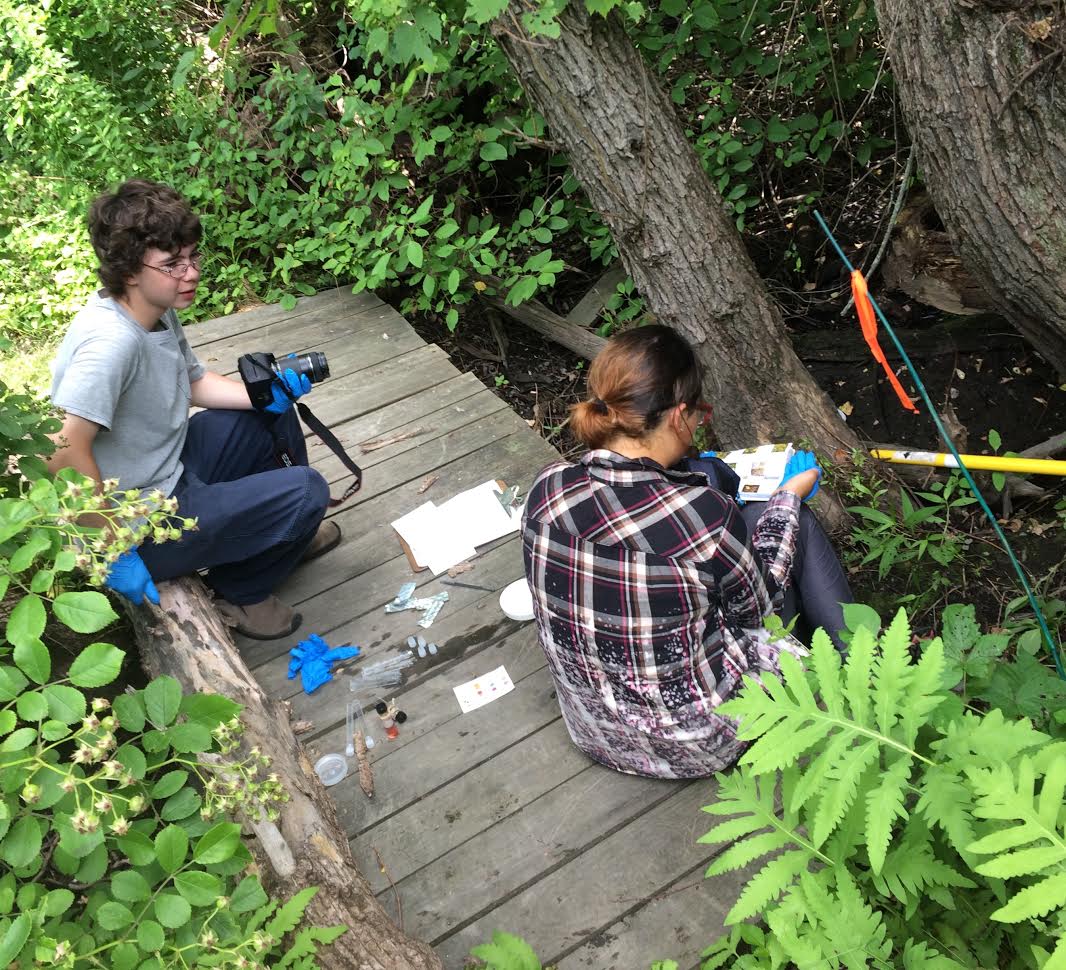
The End of Year Ecology Camp Picnic at Alewife Reservation. Campers share their learning with Boys and Girls Club of Arlington with tours and independent projects.
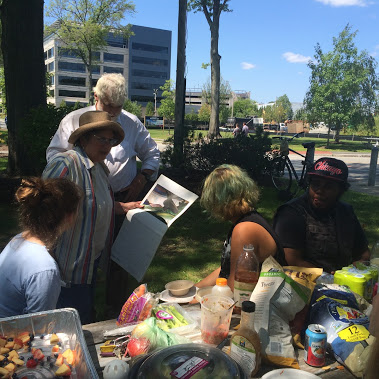
A sampling of Camp Supervisor daily logs describing Ecology Summer Camp in detail:
June 6th - First Day - By Christine
The day started off with kids trickling into the office slowly. Anthony and I introduced ourselves, gave them a packet and led them into the conference room. Eventually I stood by the front door and Anthony in the conference room. We kept up small talk / introductory conversations with them until about 9:10/9:15 when we began the orientation with brief introductions about ourselves. Then we went around the room asking each student their name and one ecology / environment based goal they have for the summer. Many had to do with learning more about the ecosystem and how animals interact as well as how other environmental factors- such as pollution affecting animals and their habitats. (More about this concept in a few paragraphs)
Right off the bat it is clear that there are a few students, who are very interested in ecology and have experience with biology, animals and identifying wildlife and plants. One has spent much time in Alewife and along Little River taking photos. He will share some with us this week.
The two truths and a lie icebreaker was a good way to get students talking and interacting a bit more amongst themselves. We tried to be as interactive as possible during our introductory slide show: asking them what animals they'd seen and where, what areas they've visited on the maps, etc. Most seem to have an interest in observing wildlife and say they look forward to this throughout the summer. A few students admit they have very little experience or interest with the outdoors, but want to have a fun summer and learn as much as they can. I enjoyed hearing their answers to our "Ecology in our lives" questions. Some were aware that we are surrounded by natures and animals at all times, some only associated "nature" and "the outdoors" with being in the woods, hiking or camping. They all seem to be fairly cautious of pollution, climate change, etc, and are already making the connection between those issues and wildlife / habitat conservation. I think this idea (connectivity) is what will keep most of their interest throughout the summer and can be applied to river restore often.
Most students did not bring lunch or water this first day- we emphasized the importance of both for the rest of camp. Especially, since they will need to eat lunch in the office during half of their break while Steve Gillies is teaching about gardening on Wednesday. I was however pleased that they did not lose momentum after their lunch break.
The students enjoyed the scavenger hunt/pole game and were impressed by the Reservation. They asked a lot of questions and I had them take note of plants and birds they found interesting to look up at a later time. They liked trying to describe the plants around where they hid the poles. We looked at directions and used the compass on my phone as a guide. After about an hour of being outside it was clear most kids were getting very hot and tired, though they stayed in good spirits. Anthony and I noted that we will need to let them take breaks in shady areas when spending a long time outdoors. The students made observation sketches of the stormwater wetland (by the amphitheatre) at the end of the day after Anthony and I went over the general guidelines for observations (provided them with sheets) and passed around examples from the 2000 Stream Team book. A few students have expressed an interest in art, and very much enjoyed the drawing / observing time. Some were clearly rushing. We will place an artistic student on each stream team. They will pair well with the more scientifically minded students. We will discuss their drawings on Weds. morning before their first real stream team field work day.
Elyshia, the MSYEP counselor met us out at the amphitheatre for about 15-20 minutes. We went over the absent students and planned a time for their workshops. MSYEP workshop will be Tuesday mornings at the High school so will not interfere with camp at all.
When we got back to the office at 2:45, we went over the plan for Wednesday , reminded them about bringing lunches and water and dismissed just before 3:00.
Overall I am happy with how the day went. Everyone was very well behaved and respectful. We were able to stick to our schedule almost exactly, which made it fairly stress-free.
Wednesday I hope to encourage more bonding between students, and spark more discussion about the environment / nature in their lives.
Wednesday 7/8 - Day 2 - by Anthony
We started the day off by having the campers briefly write in their journals. They were prompted to explain anything that might have changed in their goals for the camp after Day 1 and also to explain to the best of their knowledge what we will be doing for the River Restore project this summer. After that, Christine and I split the campers into their three Stream Teams and gave them a few minutes to come up with team names; two of the team names were Pond Squad and Er osion Explosion while the third team has not yet decided on a name.
We then set out for the reservation so that each of the teams could thoroughly explore one of their two sections, jotting down observations and making sketches of the area. Erosion Explosion was assigned section 6 (the Yates Pond area), Pond Squad studied section 5 (Yates Pond to the entrance of the North Trail), and the unnamed team was assigned section 4 (the beginning of the North Trail until the 4th bridge). Based on logistics, Christine remained with the teams in sections 5 and 6, while I stayed with the group in section 4 due to the fact that section 4 is heavily vegetated. In section 4, three key areas have been isolated thanks to our visit from Kris Houle; these areas each contain a bridge and some moderate access to the river. At each of these areas, the unnamed group first set to identifying any traces of local wildlife. Based on his extensive experience photographing animals, Jake was able to identify the footprints of a muskrat and deer. The other campers were very excited to learn methods for identifying such footprints. Next, this group identified the vegetation in each key area while one of the campers, Natalia, sketched the area. Natalia is very artistically talented so she quickly jumped at the chance to sketch the areas in section 4. It was great to see this group identify trends in their section, such as the fact that two of the three key areas were largely dominated by sensitive ferns. After reconvening with the other groups, I was happy to see that the other groups had as much success identifying and sketching in their designated sections.
After lunch, Steve Gillies arrived and briefly presented on gardening methods. He even gave some kale and rhubarb to some of the campers, encouraging them to use the vegetables to prepare some snacks for the Deer Island trip. A lot of the campers got a kick out of trying the rhubarb, which was way sourer than they had anticipated. We then made our way out to Steve's garden, where the campers participated in a wide variety of gardening techniques from weeding, watering, turning over soil, and transplanting vegetables. We even got a chance to try some more vegetables like the walking onion, which tasted a lot like scallions. Although we certainly accomplished a lot, there were certain times when some of the campers did not have a task to complete and were just standing around. This is something we will have to work to avoid in the future. If there is not enough work for everyone to get involved with a given topic, we might have to have some backup activities like games or icebreakers for idle campers to partake in. Other than that, Day 2 of camp went great! The campers really dug into the River Restore project and also seemed to find the gardening exercises very rewarding.
Monday 7/13 By Anthony
We started off the day with some journaling and discussion. Topics of interest were the following: (1) in addition to treating wastewater, what are some other ways the Deer Island facility impacts the environment, (2) what 4 species have you chosen for your individual project and why do you find them interesting?, (3) what kinds of environmental issues do we need to advocate for?, and (4) what have/will you do to help the Alewife Reservation through the River Restore project? In terms of (1), campers discussed how energy efficient the Deer Island facility is by using bacteria-produced methane to power machines and by converting sludge into fertilizer. For (2), one camper, Jackie, explained that she was very interested in the Silver Maple Forest and therefore she wanted to study a Silver Maple Tree as her plant and try to also study a mammal and bird that frequently utilize Silver Maples. Answers to questions (3) and (4) largely dealt with water quality and advocating for initiatives to clean up water sources.
Following this discussion, Christine and I split the campers into two groups: a Wiki group of 3 campers and an individual project group composed of the rest of the campers. The individual project group was instructed to use the many field and guidebooks in the storeroom to do some initial research on each of their 4 species. This research consisted of general information and some ways that these species impact the environment and other species. I was very impressed by how focused the campers were when working on these projects. They did not talk a lot amongst themselves but rather were very intently studying their species and recording information. I'm glad to see that they are very excited for this project. In the Wiki group, I instructed campers on how to navigate the Wikispaces website and edit pages within our Wiki. The 3 campers in each Wiki group were from different Stream Teams. One of the campers was instructed to enter information about our Deer Island trip, including the water treatment process as well as energy efficiency methods that the facility employs. The other 2 campers were instructed to fill in details about their designated River Restore sites that we visited last Wednesday, focusing on initial observations and wildlife that was spotted. We were able to rotate to 3 new students so that everyone got a chance to work on their individual projects and almost everyone got a chance to edit the Wiki.
Next, we gave a brief presentation on advocacy and the State House, defining key terms and explaining who we would be visiting with, before we set out for the State House. Unfortunately, Representative Provost was out sick so we met with her aide, Jordan Neerhof. The campers explained the River Restore project, talking about the water quality testing and river monitoring they plan to do this summer. Jordan was able to explain the advocacy process, even highlighting that Representative Provost had recently helped to push a bill through that focuses on restoring the Mystic River. He indicated that advocacy success rate relies a lot on what topics are "hot" in a given year and explained that advocating for Little River may be difficult given the fact that not everyone in the Cambridge and Arlington area is impacted by this river's well-being. He also emphasized that the campers can really make a difference if they spread the word to people they know, as this can help get local legislators on your side. Next, we met with Representative Roger's aide, Michael Allen. After the campers explained the River Restore project to him, Michael also gave his take on environmental advocacy, which pretty much lined up with Jordan's take. He even cited an example of Belmont students advocating for higher property taxes so that schools could benefit, which Christine and I tied to the article they will be helping us write over the course of this month. Michael also expanded his talk into broader legislation topics, touching on justice and criminology. Although not quite related to environmental advocacy, I felt that this helped the campers get a better understanding of the legislation and advocacy process. During our discussions with both aides, the campers asked really intelligent and thoughtful questions. They seemed very interested in learning how they can make a difference. Both aides that we talked to were very interested to see our Stream Team booklet upon its completion, so this will definitely be something that we will need to follow-up on at the end of the summer.
After getting back to office it was about 2:45pm, so we only had time for a quick cleanup. The campers focused mainly on making sure the conference room was clean and field and guidebooks were returned to the storeroom.
Wednesday July 15th - By Christine
Kris Houle arrived first thing to start his River Restore Work day with an hour long presentation. He talked a lot about mapping, erosion, stream bank measurements, hydrology and identification. It was helpful for the kids to see pictures and diagrams which explain more specifically what they should be looking for as far as existing conditions on their River Sites. He also talked briefly about past projects he's done, for the students to see possible results as well as possible ideas for future project on Little River. On site, stream teams went to sites 3-1. All of us stopped at site 3 first and Kris started explaining some specifics as far as measuring and cross-sectioning. He pointed out areas of erosion and why it may be that way. After "Erosion Explosion was all set up at site 3" he moved on with the other two teams further down the North Trail. I stayed with Erosion Explosion. They took very intricate measurements which they used to make more specific sketches and estimate the amount of plants in an area or more concerningly, area without plants. They really enjoyed getting on the stream bank and taking these measurements and drawings. This specific team is very enthusiastic and works well together. When the other two groups came back to site 3 with Kris, it soundd like they also had a productive time at their sites. Site 2 focused on measuring the density of plants and invasives and site 1 focused on identifying how the Silver Maple Forest Construction is affecting the hydrology and health of the area. Kris left from the parking lot and wrapped up with a brief summary. The kids seemed to learn a lot from him and get a better understanding of the River Restore project as a whole.
After we had lunch in the office, Don came to make and fly kites. Anthony and I spent a small amount of time talking abou wind in the environment during lunch and a few other times throughout camp before Don came. We made the kites in the lobby of the building. They seemed to enjoy it, but were fairly quiet during the kite making. We then walked up to the park / field area behind the Fresh Pond mall to fly them. It was fun and a good change of pace for the kids, we will ask them to relate this experience and wind to climate/weather/the environment in their journals on wednesday and have a discussion about this topic again.
Friday July 17th - By Christine
The first half of this morning was used for Stream Teams to work together to analyze the observations and data they've collected at both sites thus far. Some students brought their own computers, which made it easy for all groups to be productive. They filled out a worksheet Kris brought, which asks specific observational questions about their sites, then condensed that and the outline Anthony and I created on wiki, to write general observations, introductions and some biodiversity information in their stream team wiki. I scanned some of their sketches on to the computer and emailed them so they could include those in their wikis. They also used google maps to figure out scales of their sites.
Later in the morning, Anthony and I gave a presentation on water quality in preparation for Matt Wilson's visit. Anthony focused on the specifics of water quality testing and I focused on stormwater and relating it to Alewife. The students seemed pretty interested in the what they were learning, and asked a lot of questions and participated when we asked them questions in the presentation. So much of what they've been learning and observing thus far (and for the rest of camp) comes back to water quality, so for them to get a better understanding of the specifics and the bigger picture related to where they work was very important. I think they felt this way as well. Matt came in the afternoon and helped us organize the WQ kits while the kids were eating lunch. We wanted to take samples for nitrate, DO, coliform, temperature, turbidity and pH at all 6 sites along Little River so had to be strategic about how our trip this afternoon would work. We talked everyone to Little Pond "Site 1" where Matt worked with that site's stream team as an example for everyone. After that, we split up into stream teams and they worked their way back through the North Trail stopping at their sites. Matt came to each site with his WQ meter to compare results and take the temperature. Aside from a few students moaning and groaning about bugs and heat, most really enjoyed taking the water samples. I could tell they enjoyed working systematically and scientifically with clear goals. Once all stream teams went to their 2 sites it was the end of the day. We will go over their results on Monday and more when Matt comes back next Friday.
Friday 7/24 By Anthony
After being out on Wednesday, I was very pleased to hear that the campers had a good time studying macroinvertebrates the other day. I hope they'll be able to use their newfound skills to further improve the River Restore Project.
To prepare for our visit from Maya, we first prompted the campers to journal about ways in which art could be related to the environment or to express our feelings about the environment. After Maya arrived, Christine led the campers in a discussion about the journals in the area by the main desk while I helped Maya set things up in the conference room. Before the campers got started, Maya gave a brief introduction, explaining that she wanted the masks to focus on water, and then asked everyone to introduce themselves and explain why water is important to them. She then explained the purpose of the masks, describing them to be powerful ways that we could express our emotions and hopes for Little River. The campers were very enthusiastic when decorating their masks. All of the masks were great, but I was particularly impressed by the patterns on Mia and Zenon's masks. During the decorating process, we listened to a jazz CD that Maya brought with her, which made it a very relaxing environment.
Next, we headed out to the reservation to perform a mask ceremony near the picnic tables. Joseph, an associate of Maya's, brought a large, cow-hide drum that he played throughout the ceremony. Initially, Maya led us silently to the river's edge so that we could admire and contemplate the ways that a healthy river would benefit the reservation. Then we donned our masks and circled around Joseph as he played his drum. First, Joseph led us in a chant and then he put on a turtle-like outfit before he asked us to speak about what hopes we have concerning the health of Little River. After this, Maya led us in a brief chant to close out the ceremony. The campers and myself included obviously felt a little awkward at the start of the ceremony, but I was happy to see that many of them loosened up a bit and really started to get into the spirit of the thing, Niko in particular. Unfortunately, David chose not to join us in the ceremony, and after speaking with him, he explained to me that he was uncomfortable with the spiritual and religious aspect of it, which is something I can understand.
After some lunch at the picnic tables, Matt Wilson met us and we parted ways with Maya and Joseph. Matt led us to the Stormwater Wetlands, where he discussed the overall layout of the reservation and how the winding pathway of the water prolongs the treatment process. We then made our way back to the office, where Matt gave an additional presentation about water quality and ideal ways the campers could present their results. By that time it was nearly 3, so we instructed the campers to clean up the room and then we dismissed them.
Monday July 27th By Christine
This morning when the youth came in we split the time between individual projects and wikis. At this point, most have found all the information they can from the guide books for their individual projects, so Anthony and I prompted them to begin elaborating on the information, draw sketches and organize it into binders. We have encouraged the kids to bring their own computers to assist with finishing up their individual projects and for other work periods like this.
Amy came in at 10am to begin her insect workshop. She started with a presentation on different species of bugs and why they are important. She stopped several times throughout to interact with the kids, which helped them remember what she taught and use the information later in the day on their sites. After her presentation she passed around several preserved insects, such as flies, wasps, and luna moths for the kids to identify and sketch. After this activity we had a short lunch in the conference room. The kids are enjoying socializing with each other more at lunch and interacting much more than they were at the beginning. A lot of talk about books and music, show that they are very intellectual young people. After their free time at lunch, Amy explained the dragonfly worksheet before we headed out to the Reservation. Each Stream Team was equipped with a butterfly net and an guide book. Amy taught us how to catch and identify at the first site, then the stream teams split up to sites 6-4. They spent a bit over 30 minutes at their sites. I stuck with Pond Squad at site 5. They found what I thought to be a surprising amount dragonflies. 8 different species and 25 insects total. As Amy said, there must be some aspect of water quality that dragonflies do not rely on to survive. When each team was done at their site we gathered at the picnic tables and compared results.
After Amy left we spend about 20 minutes in the native garden weeding and watering. We'll spend more time on this tomorrow, as there is a lot more weeding to be done.
When we got back to the classroom around 2:15, we had the youth enter their results from today in their stream teams as well as work on other wiki pages. They cleaned up around 2:45, then headed out for the day just before 3.
- Home
- Directions
- FAR Wildlife Blog
- Calendar
- News
- Donate Now
- Get Social!
- Storm Water Wetlands
- Plants and Restoration
- Photos
- Videos
- About & Projects
- Master Plan for Alewife
- Archive
- Newsletters
- Contact
 Presentation Spotlighting Alewife Reservation
Presentation Spotlighting Alewife Reservation
 Follow us on Twitter
Follow us on Twitter
 Like us on Facebook
Like us on Facebook
 Follow us on Instagram
Follow us on Instagram
Forward our web address to a friend!
- An Urban Gem - Alewife Reservation Nature Preserve
- Envisioning The Silver Maple Forest
- History and Policies of Cambridge, Belmont, and DEP
- Storm Water Wetlands
- Friends of Alewife Reservation brochure
(front, back) - Technical Analysis of Upper Alewife Basin
- Watershed: An Excursion in Four Parts
- The River Is A Restless Spirit: Life in the floodplain forest
-
Assessment of Silver Maple forest for DEP Adjudicatory hearings and
Patrick Fairbairn, author of the Assessment - Community Native Garden Flora
The
Alewife Reservation
is a unique natural resource for the communities of Belmont, Arlington and Cambridge
and home to hundreds of species, including hawks, coyotes beavers, snapping turtles, wild turkeys and muskrats,
the reservation is a unique natural resource for the community.
Historical information (Powerpoint)
Friends of Alewife Reservation works to protect and restore this wild area and the surrounding area for the water quality, native plants, animals and over 90 bird species with paths for walking, running and biking, recreation, and for classroom education and research. We regularly steward and preserve the Reservation area for wildlife and for the enjoyment of present and future generations.

(video)
By-Laws
About Friends of Alewife Reservation
Statement of Purpose
Citizen Forester newsletter archive
The Birds of the Cambridge Region of Massachusetts

by William Brewster 1906
Nuttal Ornithological Society
Biodiversity Study of Alewife Reservation Area: Species, Habitat, Ecosystems

Inventories by David Brown, wildlife assessor (2003, 2004.) Published by and available from FAR for $10. Write or call for your copy. (sample)
Updated Dave Brown Inventories (2008, 2010)
Inventories of Alewife Reservation Wetland Plants by Walter Kittredge, Botanist (2013)
